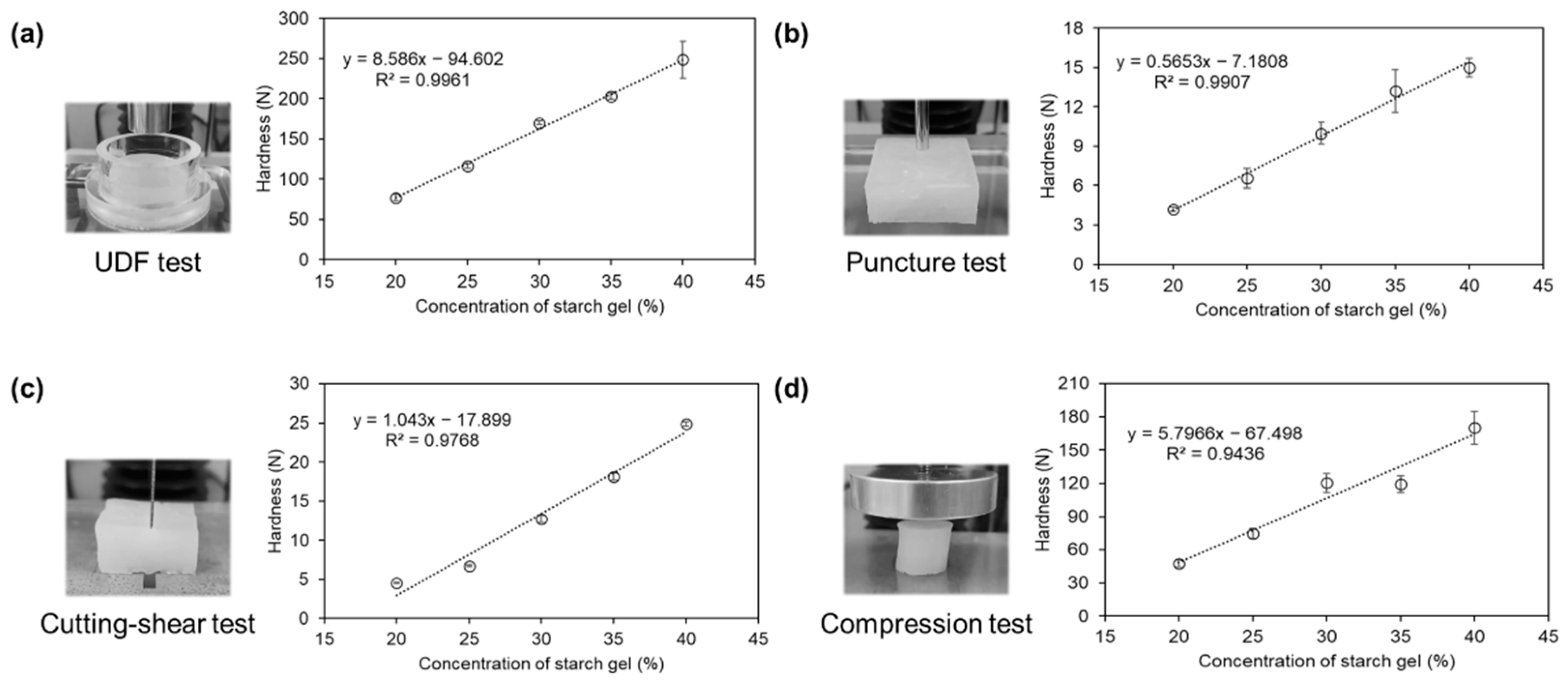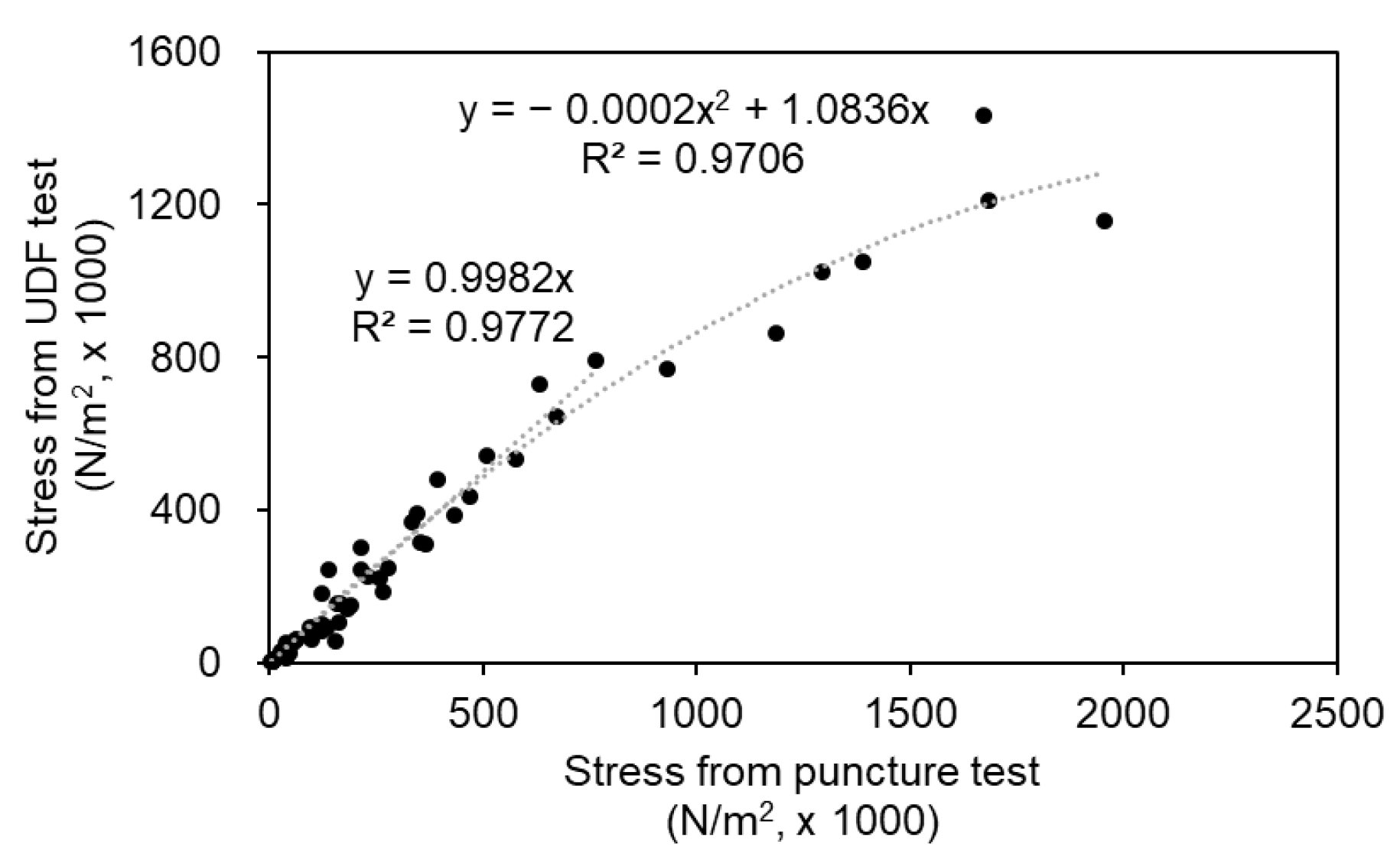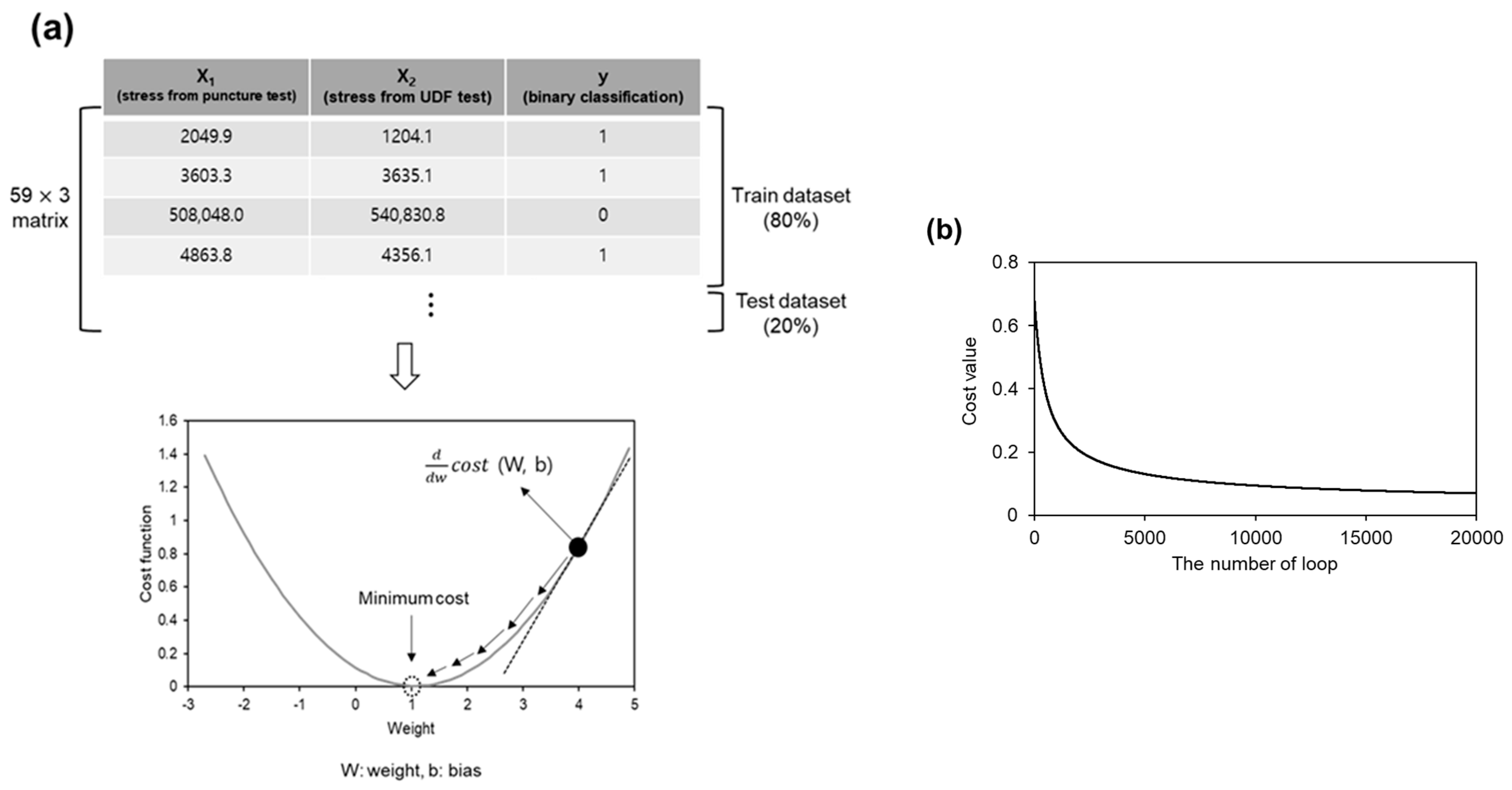Rheology-Based Classification of Foods for the Elderly by Machine Learning Analysis
Abstract
:1. Introduction
2. Materials and Methods
2.1. Materials
2.2. Preparation of Starch/Hydrocolloid Gels and Blanched Radishes/Carrots
2.3. Rheological Measurements
2.4. Machine Learning Analysis
3. Results and Discussion
4. Conclusions
Author Contributions
Funding
Institutional Review Board Statement
Informed Consent Statement
Data Availability Statement
Conflicts of Interest
References
- World Population Prospects 2019: Highlights. Available online: https://www.un.org/development/desa/publications/world-population-prospects-2019-highlights.html#:~:text=The%20world’s%20population%20is%20expected,United%20Nations%20report%20launched%20today (accessed on 2 February 2021).
- Youn, H.M.; Lee, H.J.; Lee, D.W.; Park, E.-C. The impact of poverty transitions on frailty among older adults in South Korea: Findings from the Korean longitudinal study of ageing. BMC Geriatr. 2020, 20, 1–10. [Google Scholar] [CrossRef] [Green Version]
- Nyberg, M.; Olsson, V.; Pajalic, Z.; Örtman, G.; Andersson, H.S.; Blücher, A.; Wendin, K.; Westergren, A. Eating difficulties, nutrition, meal preferences and experiences among elderly: A literature overview from a Scandinavian context. J. Food Res. 2015, 4, 22–37. [Google Scholar] [CrossRef]
- Kawashima, K.; Motohashi, Y.; Fujishima, I. Prevalence of dysphagia among community-dwelling elderly individuals as estimated using a questionnaire for dysphagia screening. Dysphagia 2004, 19, 266–271. [Google Scholar] [CrossRef] [PubMed]
- Blanař, V.; Hödl, M.; Lohrmann, C.; Amir, Y.; Eglseer, D. Dysphagia and factors associated with malnutrition risk: A 5-year multicentre study. J. Adv. Nurs. 2019, 75, 3566–3576. [Google Scholar] [CrossRef]
- McCullough, G.; Pelletier, C.; Steele, C. National dysphagia diet: What to swallow? ASHA Lead. 2003, 8, 16–27. [Google Scholar] [CrossRef]
- Ashraf, H.H.; Palmer, J.; Dalton, H.R.; Waters, C.; Luff, T.; Strugnell, M.; Murray, I.A. Can patients determine the level of their dysphagia? World J. Gastroenterol. 2017, 23, 1038. [Google Scholar] [CrossRef]
- Aguilera, J.M.; Park, D.J. Texture-modified foods for the elderly: Status, technology and opportunities. Trends Food Sci. Technol. 2016, 57, 156–164. [Google Scholar] [CrossRef]
- Fujisaki, T. Universal Design Foods. J. Jpn. Soc. Food Sci. 2008, 55, 78. [Google Scholar]
- Cichero, J.A.; Lam, P.; Steele, C.M.; Hanson, B.; Chen, J.; Dantas, R.O.; Duivestein, J.; Kayashita, J.; Lecko, C.; Murray, J. Development of international terminology and definitions for texture-modified foods and thickened fluids used in dysphagia management: The IDDSI framework. Dysphagia. 2017, 32, 293–314. [Google Scholar] [CrossRef] [PubMed] [Green Version]
- Schleder, G.R.; Padilha, A.C.; Acosta, C.M.; Costa, M.; Fazzio, A. From DFT to machine learning: Recent approaches to materials science–A review. J. Phys. Mater. 2019, 2, 032001. [Google Scholar] [CrossRef]
- Jordan, M.I.; Mitchell, T.M. Machine learning: Trends, perspectives, and prospects. Science 2015, 349, 255–260. [Google Scholar] [CrossRef]
- Ongsulee, P. Artificial intelligence, machine learning and deep learning. In Proceedings of the 2017 15th International Conference on ICT and Knowledge Engineering (ICT&KE), Bangkok, Thailand, 22–24 November 2017; pp. 1–6. [Google Scholar]
- Nilashi, M.; bin Ibrahim, O.; Ahmadi, H.; Shahmoradi, L. An analytical method for diseases prediction using machine learning techniques. Comput. Chem. Eng. 2017, 106, 212–223. [Google Scholar] [CrossRef]
- Vayena, E.; Blasimme, A.; Cohen, I.G. Machine learning in medicine: Addressing ethical challenges. PLoS Med. 2018, 15, e1002689. [Google Scholar] [CrossRef] [PubMed]
- Scher, S.; Messori, G. Predicting weather forecast uncertainty with machine learning. Q. J. R. Meteorol. Soc. 2018, 144, 2830–2841. [Google Scholar] [CrossRef]
- Sarkar, S.; Vinay, S.; Raj, R.; Maiti, J.; Mitra, P. Application of optimized machine learning techniques for prediction of occupational accidents. Comput. Oper. Res. 2019, 106, 210–224. [Google Scholar] [CrossRef]
- Li, Z.; Meier, M.A.; Hauksson, E.; Zhan, Z.; Andrews, J. Machine learning seismic wave discrimination: Application to earthquake early warning. Geophys. Res. Lett. 2018, 45, 4773–4779. [Google Scholar] [CrossRef] [Green Version]
- Bisgin, H.; Bera, T.; Ding, H.; Semey, H.G.; Wu, L.; Liu, Z.; Barnes, A.E.; Langley, D.A.; Pava-Ripoll, M.; Vyas, H.J. Comparing SVM and ANN based machine learning methods for species identification of food contaminating beetles. Sci. Rep. 2018, 8, 1–12. [Google Scholar] [CrossRef]
- Erban, A.; Fehrle, I.; Martinez-Seidel, F.; Brigante, F.; Más, A.L.; Baroni, V.; Wunderlin, D.; Kopka, J. Discovery of food identity markers by metabolomics and machine learning technology. Sci. Rep. 2019, 9, 1–19. [Google Scholar] [CrossRef] [PubMed] [Green Version]
- Jiménez-Carvelo, A.M.; González-Casado, A.; Bagur-González, M.G.; Cuadros-Rodríguez, L. Alternative data mining/machine learning methods for the analytical evaluation of food quality and authenticity–A review. Food Res. Int. 2019, 122, 25–39. [Google Scholar] [CrossRef]
- Ministry of Food and Drugh Safety in South Korea, Food Code. Available online: https://www.foodsafetykorea.go.kr/foodcode/03_01.jsp (accessed on 21 February 2021).
- Park, J.D.; Cho, B.K.; Kum, J.S.; Lee, H.-Y. Quality properties of cooked germinated-brown rice. Korean J. Food Preserv. 2005, 12, 101–106. [Google Scholar]
- Góral, D.; Kluza, F. Cutting test application to general assessment of vegetable texture changes caused by freezing. J. Food Eng. 2009, 95, 346–351. [Google Scholar] [CrossRef]
- Kim, Y.; Kim, H.; Lee, S. Artificial saliva-induced structural breakdown of rice flour gels under simulated chewing conditions. Food Sci. Biotechnol. 2019, 28, 387–393. [Google Scholar] [CrossRef]
- Bourne, M. Food Texture and Viscosity: Concept and Measurement, 2nd ed.; Academic Press: Cambridge, MA, USA, 2002. [Google Scholar]
- Kim, H.; Oh, I.; Yang, S.; Lee, S. A comparison of rheological measurement methods of instant cooked rice by a texture analyzer. Food Eng. Prog. 2018, 22, 381–385. [Google Scholar] [CrossRef]
- Lee, S.; Kim, Y. Food Rheology: Principles and Applications; Soohaksa: Seoul, Korea, 2017; ISBN 978-89-7140-708-0. [Google Scholar]
- Korean Industrial Standards: Seniors Friendly Foods (KS H 4897). Available online: https://e-ks.kr/streamdocs/view/sd;streamdocsId=72059203773233835 (accessed on 21 February 2021).
- Kim, Y.; Kim, H.J.; Cho, W.; Ko, S.; Park, S.K.; Lee, S. Classification of starch gel texture for the elderly diets based on instrumental and sensory methodology. J. Texture Stud. 2017, 48, 357–361. [Google Scholar] [CrossRef]
- Ruder, S. An overview of gradient descent optimization algorithms. arXiv 2016, arXiv:1609.04747. [Google Scholar]
- Chang, M.-W.; Yih, W.-T.; Meek, C. Partitioned logistic regression for spam filtering. In Proceedings of the 14th ACM SIGKDD International Conference on Knowledge Discovery and Data Mining, Las Vegas, NV, USA, 24–27 August 2008; pp. 97–105. [Google Scholar]
- Sharma, A.S.; Prince, S.; Kapoor, S.; Kumar, K. PPS—Placement prediction system using logistic regression. In Proceedings of the 2014 IEEE International Conference on MOOC, Innovation and Technology in Education (MITE), Patiala, India, 19–20 December 2014; pp. 337–341. [Google Scholar]
- Park, H.; Um, K.H.; Lee, S. A hardness survey on crushed meat products in the Korean Market for the development of meat foods for seniors. Food Eng. Prog. 2019, 23, 139–145. [Google Scholar] [CrossRef]
- Pendharkar, P.C. A threshold-varying artificial neural network approach for classification and its application to bankruptcy prediction problem. Comput. Oper. Res. 2005, 32, 2561–2582. [Google Scholar] [CrossRef]
- Selvakumar, S.; Kannan, K.S.; GothaiNachiyar, S. Prediction of diabetes diagnosis using classification based data mining techniques. Int. J. Stat. Syst. 2017, 12, 183–188. [Google Scholar]
- Phillips, J.; Cripps, E.; Lau, J.W.; Hodkiewicz, M. Classifying machinery condition using oil samples and binary logistic regression. Mech. Syst. Signal Process. 2015, 60, 316–325. [Google Scholar] [CrossRef]





| Classification by Korean Food Code | Samples |
|---|---|
| Confectionery, Bread, or Rice Cakes | Brownie (Orion, Seoul, Korea), Butter roll bread (SPC, Gyeonggi-do, Korea), Plain bread (Lotte, Seoul, Korea), Sweet red bean jelly (Haitai, Seoul, Korea), Baekseolgi (Rice cake shop, Seoul, Korea), Garaetteok (Rice cake shop), Jeungpyeon (Rice cake shop), Injeolmi (Rice cake shop), Jeolpyeon (Rice cake shop), Sticky rice cake (Rice cake shop), Sirutteok (Rice cake shop), Pudding custard (CJ Cheiljedang, Gyeong-gi, Korea), Yakgwa (Hanul confectionery, Gyeong-gi, Korea), Chiffon cake (SPC), Pound cake (SPC) |
| Jams | Strawberry jam (Ottogi, Gyeong-gi, Korea) |
| Tofu or Jellied Food | Tofu (Pulmuone, Seoul, Korea) |
| Soybean Sauces | Gochujang (CJ Cheiljedang), SSamjang (CJ Cheiljedang) |
| Salted or Boiled Foods | Pickled radish (Ilga, Sejong-si, Korea) |
| Processed Agricultural Products | White mushroom (Moring Farm, Gyeongsang, Korea) |
| Processed Meat and Packaged Meat | Smoked ham (Samhoham, Gyeong-gi, Korea), Sausage (Lotte), Frank sausage (Hansung, Gyeongsang, Korea), Chicken steak (Farmsco, Gyeong-gi, Korea), Brown rice chicken steak (Haetsal Food System, Gyeong-gi, Korea), Hamburg steak (CJ Cheiljedang), Hamburg steak (Ottogi) |
| Dairy Products | Mozzarella cheese (Saputo, Montreal, Canada), Monterey jack cheese (Great lakes cheese, Hiram, Georgia, USA), Cheddar cheese (Great lakes cheese) |
| Fishery Products | Fish cake bar (Sajo, Gyeong-gi, Korea) |
| Instant Foods | Instant rice (CJ Cheiljedang), Instant abalone porridge (CJ Cheiljedang) |
Publisher’s Note: MDPI stays neutral with regard to jurisdictional claims in published maps and institutional affiliations. |
© 2021 by the authors. Licensee MDPI, Basel, Switzerland. This article is an open access article distributed under the terms and conditions of the Creative Commons Attribution (CC BY) license (http://creativecommons.org/licenses/by/4.0/).
Share and Cite
Jeong, S.; Kim, H.; Lee, S. Rheology-Based Classification of Foods for the Elderly by Machine Learning Analysis. Appl. Sci. 2021, 11, 2262. https://doi.org/10.3390/app11052262
Jeong S, Kim H, Lee S. Rheology-Based Classification of Foods for the Elderly by Machine Learning Analysis. Applied Sciences. 2021; 11(5):2262. https://doi.org/10.3390/app11052262
Chicago/Turabian StyleJeong, Sungmin, Heesu Kim, and Suyong Lee. 2021. "Rheology-Based Classification of Foods for the Elderly by Machine Learning Analysis" Applied Sciences 11, no. 5: 2262. https://doi.org/10.3390/app11052262
APA StyleJeong, S., Kim, H., & Lee, S. (2021). Rheology-Based Classification of Foods for the Elderly by Machine Learning Analysis. Applied Sciences, 11(5), 2262. https://doi.org/10.3390/app11052262






